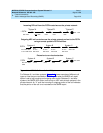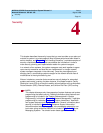
MERLIN LEGEND Communications System Release 6.1
Network Reference
555-661-150
Issue 1
August 1998
Feature Interactions
Page 3-27Voice Announce to Busy
3
Transfers across networked systems over tandem tie trunks do not return to the
transferring extension. If such a call is transferred to a busy or invalid non-local
dial plan extension or one with Do Not Disturb turned on, the transferred party
hears busy or fast busy tone and must hang up and call back in order to speak
with someone. If a transfer is made across a private network over tandem PRI
trunks only, it returns to the transfer originator in the event that the intended
destination is busy, invalid, or has turned on Do Not Disturb.
For Release 6. and later systems, when a centralized automated attendant
transfers a call to a non-local extension, the transferring system monitors the call
to ensure that it is answered. If the non-local extension is not available or the call
is not answered within the fixed redirect interval (32 seconds), the call stops
ringing at the remote destination and is redirected to an extension on the
transferring system (the system with the centralized VMS/AA) that is programmed
to receive redirected calls. This extension can be the first QCC queue, another
extension, or a calling group (the call is directed to an available member and not
sent to calling group coverage).
NOTE:
Calls transferred by the VMS/AA to a calling group with a non-local
member, and all UDP routes are busy, will go to the redirect destination
upon transfer completion. If a transferred call travels over a loop-start or
ground-start line to the PSTN, it will not return for redirection.
Voice Announce to Busy 3
Voice-announced calls arrive at non-local dial plan extensions as ringing calls and
not as voice calls.
Voice Messaging Interface (VMI) 3
In Release 6.0, each system in a private network must have its own voice mail
application. However, an automated attendant application can route calls to a
non-local dial plan extension (requires Release 6.0, Version 11). A single system
must include both the application and all PSTN trunks that call into the application.
Also, some VMS applications transfer calls only to extensions with a predefined
number of digits (for example, to 4-digit extensions only).
Private trunks must be numbered uniquely and without ambiguity across the
private network; 4-digit line/trunk numbers are recommended for this
configuration. To avoid ambiguity, trunks should not be numbered as, for example,
890 and 8900.
For Release 6.1 and later, group coverage and calling group overflow calls can be
routed from one MERLIN LEGEND Communications System to another MERLIN
LEGEND Communications System over tandem PRI or tie trunks providing that
the two systems are directly connected by the tandem trunks.


















